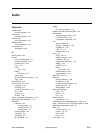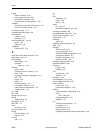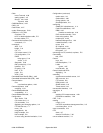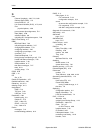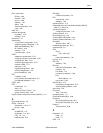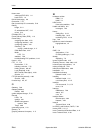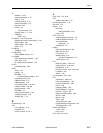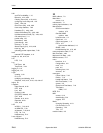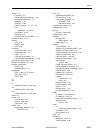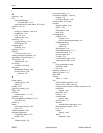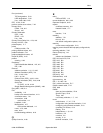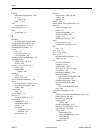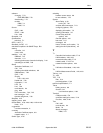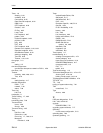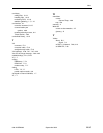
Index
IN-12
September 2002 9128-A2-GB20-80
Routing
Information Protocol (RIP), 4-99
IP, 5-3
table, 7-48
table, 1-7, 5-3
RTS
control lead, 7-11
running reports, 11-6
RXD
control lead, 7-11
S
Sampling
SLV Inband and Interval, 4-28
saving configuration options, 3-6
scheduled activations, 9-8–9-9
Scratchpad Configuration, 3-3
screen
area, 2-5
function keys area, 2-5
how to navigate, 2-6
scrolling through valid selections, 2-9
Secondary Clock
Failed, 7-24–7-25, 8-12
Source, 4-32
security, 1-5, 2-2, 2-9, 3-5, 6-1
router, 5-14
SNMP NMS
options, 4-87
selecting
a field, 2-9
from a menu, 2-8
Self-Test Results messages, 7-19
Send
All Ones on DSX-1 Failure, 4-44
and monitor test pattern, 8-34
Pattern, 8-24
serial number
NAM, 7-3
server, DHCP, 5-11
Service, A
Profile ID (SPID), 4-45, F-7
service level
management, 1-11
management (SLM), 1-1
reports, 11-6
verification
configuring, 4-28
statistics, 7-52
verifier (SLV), 1-1
Session
Access Level, 4-85, 6-6, 6-8
ending, 2-3
starting, 2-2
Set DE, 4-78
setting Date & Time (system clock), 4-5
setting up
auto-configuration, 4-8
DBM, 4-12
in-band management, 5-15
ISDN link profiles, 4-49
modem, 4-6
SNMP trap managers, 4-87
show
CLI commands, C-25
configuration command, 5-16
SIG
LED, 7-10
SLA, 1-10–1-11
SLIP, 4-100, 4-102
SLM, xi, 1-11
(service level management), 1-1
OpenLane, 9-2
SLV
(service level verifier), 1-1
configuring, 4-28
Delivery Ratio, 4-29
DLCI Down on Timeout, 4-29
Packet Size, 4-30
performance statistics, 7-52
Round Trip Latency
Clearing Event Threshold, 4-30
Error Threshold, 4-30
Sample Interval (secs), 4-28
Synchronization Role, 4-28
Timeout
Error Event Threshold, 4-29
type, 4-28
smurf attack prevention, 5-15
SNMP
assigning community names/access levels, 6-10
limiting access, 6-9, 6-11
Management, 4-83, 6-9
NMS security
options, 4-87
Number of Managers, 4-87
setting up Trap Managers, 4-87
trap event log, 7-69, 8-14
Traps, 4-88
downloading, B-2
setting up DBM to send, 4-18
standards, B-8
supported, 8-2
validation, 4-76



